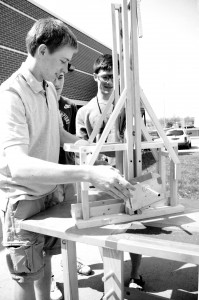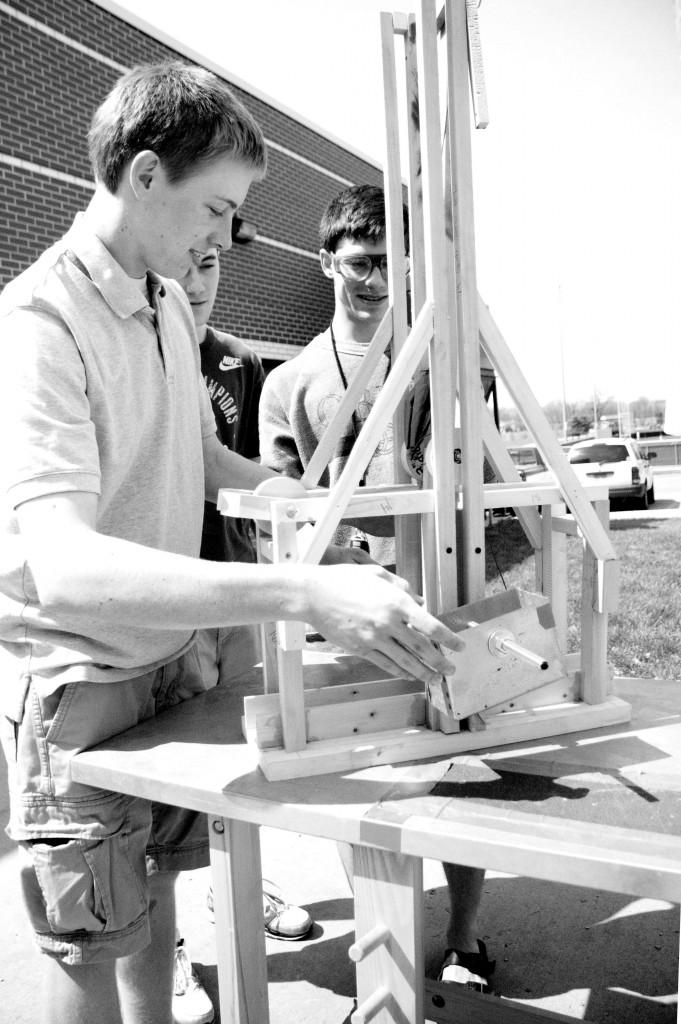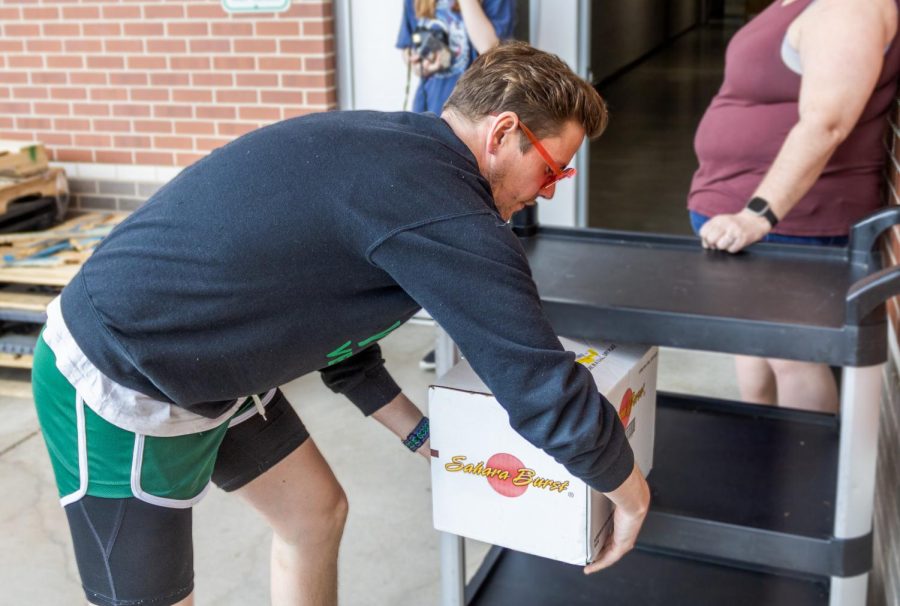
Between graphing logarithms, flipping through flashcards and wondering what on earth a gerund could be, students have the opportunity to put their imaginations, rather than their memories, to the test. Here are just a few of the classes that spice up the course description book.
Industrial Design
Buzzing saws and fluttering blueprints abound in the secluded corner of the school where Industrial Design is held. Projects in this course vary from year to year, but the current class has built furniture, trebuchets (catapults), scooters and more.
The current state of the economy sometimes forces the class to find ways around purchasing items that cost more now than they did a few years ago, but according to Industrial Design teacher Don Clancy, such constraints have not hindered students’ abilities to build.
“We have to decide what materials we’re going to use and if those materials are even available,” Clancy said.
As he spoke, a student rolled by on a wooden “sidewalk scooter.” To save money, the class crafted the wheels from scratch, exemplifying one way in which students have been able to find creative solutions to financial obstacles.
Some of the furniture the class created was sold to fund Free State’s chapter of SkillsUSA, a nationwide organization for America’s future workforce. As for the trebuchets, Clancy divided the class into two competing teams–one group each of sophomores and seniors (no juniors are in the class)–to see who could build the better machine.
“I regret to tell you that the sophomores won overwhelmingly,” Clancy chuckled. “They really put their nose to the grindstone.”
The sophomores’ trebuchet sent a golf ball reeling over 300 feet while the seniors’ only managed to reach 66.
Next year, Clancy hopes to build a hovercraft.
Music Theory/Jazz Improvisation
Sophomore Luke Peirce estimates that Music Theory/Jazz Improvisation is “75 percent creativity.” No, that’s not a proven fact–but this is music, not AP Statistics.
Music Theory/Jazz Improvisation, unlike the usual Band and Orchestra, allows students to get their hands dirty with musical composition.
“This is a really good [course] for students who want to go into jazz, especially if they’re thinking about trying out for jazz band in college or in high school,” Assistant Band Director Meghan Hardy said. “It’s also for students who have bands that allow them to do solos.”
Peirce hopes to someday major in music composition, but the class is not only for aspiring Mozarts. Even Rebecca Black wouldn’t be turned away.
“We have students who have done AP Music Theory, students who can’t read music, and everything in between,” Hardy said.
Class assignments usually involve studying and analyzing pieces that are performed “in the real world,” as Hardy put it.
“We learn scales, we learn the process some soloists go through to learn a solo, and then we’ve been working on creating bass lines when there’s no music provided,” she said. She added, however, that the class has squeezed “some pretty good jam sessions” into all of that hard work.
Textiles and Fashion
Artistic minds take to the runway in Textiles and Fashion, where students learn to thrive in the glamorous world depicted between the pages of glossy magazines.
“I have quite a few students who are seriously thinking about going on to fashion school,” teacher Linda Graverholt said.
The course is by no means restricted to future designers. Students simply hoping to add some paparazzi-worthy pizazz to their closets are welcome, too.
“I didn’t really like it for the first while because we were learning facts about fashion and fashion history, which kind of bored me to tears,” junior Candice Meiners admitted. “But then when we started getting to the practical stuff, like actually cutting stuff up, I enjoyed it. I like sewing and making things. I’m a making-things type of person.”
“Right now [students] are either doing a portfolio project or their own sewing project,” Graverholt said. She has received a wide range of finished works in the past, including dresses, handbags and other garments.
“I’ve had one person do draperies to hang up in their bedroom,” she said. “I really like to see what they do with the parameters of the assignment.”










![After receiving advice from her students, orchestra director Judy Erpelding marks her music. Although the director normally makes the artistic decisions, Erpelding will often consult her students and hear their opinions on what sounds good and what they should try out. “[The students] are the heart of the program, not me,” Erpelding said. “I know they will carry that on and I will miss them. Making great music with them, being able to challenge them, taking their inspiration.”](https://www.fsfreepressonline.com/wp-content/uploads/2023/05/Roust_Erpelding_5_11_23-600x900.jpg)

